September 15th, 2009 · No Comments
-
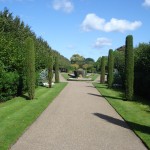
-
Regents Park
-
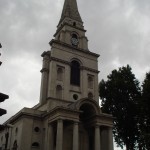
-
Christ’s Church
-
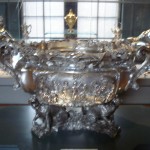
-
The Silver Exhibit in the V&A
-
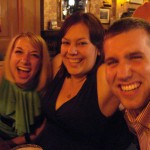
-
Having a Good Time at the Fitzroy
Like many of my classmates I decided it would be worthwhile to summarize all of my discoveries this month in London. During this post I will focus on six main themes found within London: Parks, Churches, Pubs, Other Religious Institutions, Theatre and Museums.
Parks
Each park that I visited had its own distinct characteristics that separated it from any other. Green Park was the first I visited and after perusing a few others, I realized there was nothing that exciting about it. Located right across from Buckingham Palace, Green Park certainly provides a good place to go and take a break from the busy atmosphere of the area. Besides this however there is not much going on and I would recommend that potential park goers walk the extra distance over to St. James Park.
In addition to the large number of waterfowl heckling people for food which offers consistent entertainment St. James offers some picturesque flower beds throughout and various monuments along the way. It has the relaxing atmosphere of Green Park with a bit more excitement sprinkled in.
Regents Park offers a completely different feel from Green or St. James. Located in a separate area of London, Regents Park has a history of being used by a higher end crowd. I could tell this immediately from the feel of the park. The decorative shrubbery and elegant architecture throughout gave me a feeling that Regents is not as well used as other parks.
Since I was one of the members of the Parks group that gave a walking tour of Hyde Park and Kensington Gardens I could go into a lot more detail about these two green spaces but I will choose not to in an effort to be concise. In summary Hyde Park is the largest green space in London and is often used for larger events such as concerts, festivals etc. It also contains a large number of monuments throughout including the 7/7 memorial and the Diana Memorial Fountain. Kensington Gardens is home to a variety of key monuments but is not as well trodden as Hyde. Overall it makes for a quieter atmosphere, more conducive fo reading or “snogging”.
Regents Park were my two favorite green spaces in London. Regents, is both beautiful, and extremely large and I continually felt the need to go back and explore. Kensington Gardens appealed to me in that it was quainter than Hyde Park but contained a like amount of history and monuments throughout. Although I would be content spending a length of time in any London green space Regents and Kensington would be my top choices.
Theatre
Overall I enjoyed going to the theatre on so many occasions. What better place to do so than in London after all? Here I will discuss my favorite performances and theatre venues.
All in all I enjoyed all but two of the performances we saw. The two Shakespeare productions at The Globe Theatre were fantastic. Although I did not particularly enjoy reading Troilus and Cressida it made a huge difference to be there so close to the actors. The fantastic drum chorus at the end really sealed the deal. As You Like It was probably my favorite show I saw here in London. Although it is one of Shakespeare’s simpler plays the actors really made it jump off the page. Being down it the pit was fantastic because of all the ad-libbing and constant interaction with the crowd. I even felt traces of Touchstone’s saliva on my arm at one point.
The other Shakespeare performance I saw, All’s Well That Ends Well, was lackluster. Although the Olivier was my favorite performing venue (this is what an auditorium style theatre should be like…why can’t Dickinson have something like this?) the play itself was odd and ended on an abrupt and odd note.
The other play we saw at the National Theatre, The Pitmen Painters, was fantastic. Although I was dozing a bit because of the Benadryl I took right before the show, the actors kept my attention and I appreciated that the play was based off of a true story.
Easily the oddest play we saw was Arcadia. An extremely intelligent performance the play juxtaposed two different periods in time and created a singular storyline in which the plot was based. Overall it was an entertaining performance that made me think early and often.
Finally there was Blood Brothers. The lone musical I saw produced feelings of disbelief, anguish and held back laughter. The ridiculous 80’s sound track and creepy narrator just didn’t do it for me. I think it’s safe to say that I was not the only one from Humanities 309 who was a bit surprised to see just about everyone in the audience give it a standing ovation.
I had a very positive experience with the theatre here. I would go back to the globe again and again. I loved being that close to the action. I would also enjoy seeing another show in the Olivier. There really is so much to choose from here. It’s simply a matter of figuring out your tastes and saving your money so you can see a lot of performances.
Churches
From Westminster Abbey to St. Paul’s Cathedral we saw most of the major churches/cathedrals during our month in London. St. Paul’s was easily my favorite. From the fantastic crypt to the hundreds of stairs up to the tower it had so much to offer in the way of history and mystique. Westminster Abbey fascinated me primarily because of all the literary figures that had been buried inside as well as the room that was dedicated to “The Order of the Bath”. Other churches that I really enjoyed taking a look at were: “St. Martin in the Fields” which sits just outside Trafalgar Square and Nicholas Hawkesmoore’s “Christ’s Church” which is located in very close proximity to Brick Lane.
Other Religious Institutions
Overall the Sikh Gurdwara was my favorite place that we visited. I appreciated the simplicity of the religious doctrine as well as the conviction and honesty with which our tour guide, Mr. Singh spoke. The morning was capped off with a fantastic sit down meal together in which everyone was served the same food and drink.
I had different feelings about the Hindu Mandir. It was clear to me from the very beginning that the Hindu religion is not nearly as modest as Sikhism nor are they trying to be. From the extremely decorative prayer room, to the museum located right in the center of the Mandir I never felt particularly comfortable inside.
The only religious institution I wish we had gotten a chance to visit is a Mosque. I had been to one many years ago but I did not remember a whole lot from my experience. I wonder how much more lively the East End, and all parts of London would be if Ramadan were not taking place during our time here.
Museums
I could go on and on about museums so I will attempt to stay as concise as possible.
The British Museum was massive, convenient since it was so close to the Arran House but a little one dimensional at times. One of my favorite exhibits at the British Museum was a special exhibit on Living and Dying that drew information from all different time periods and cultures.
The National Gallery was fantastic. Although I have a hard time appreciating some visual art the gallery kept my attention for a number of hours. Seeing so many famous works of art was phenomenal.
The Tate Modern was my least favorite museum here. Although I am trying I have a hard time understanding modern art. After about 45 minutes in this museum it ended up being too much for me.
The Cabinet War Rooms/Churchill Museum were two of my favorites. The realization that I was standing in one of the most important places in World War II history was unbelievable. The War Rooms felt so authentic. I really felt as though I had been taken back in time to the 1940’s while inside.
The Victoria and Albert was easily my favorite museum in London. There was so much variety inside and so much to see. I could have easily spent a few days inside. Two of my favorite exhibits were the silver and jewelry exhibits. I’m not sure what this says about me as a person but I found it unbelievable that individuals could even own such treasures. I also enjoyed the laid back atmosphere of the V&A staff. At most of the other museums I visited I felt like I was doing them a disservice simply by being there. Although I understand that taking pictures of an object in a museum doesn’t do it justice I like to be able to have the option of doing so.
The Sir John Soane museum interested me but it wasn’t really my cup of tea in the end. It also had a stuffy atmosphere to it that I didn’t really appreciate.
One thing I can draw from my experience at museums here is that each and every one has something that distinguishes it. With so many museums I thought that it would be impossible to avoid some overlap but I never really felt that. Cheers to London and its museums.
Pubs
Finally we have pubs. What would London be without it’s public houses? In some cases pubs are the true museums of London, designating what an area was like in the past and what type of clientele it attracted. During my month here I had a chance to visit a few pubs and get a general sense of what some possible differences could be. It is clear to me that each pub brings something different and unique to the table. The Marlborough Arms was convenient being so close to the Arran House and was a great place to enjoy a pint over a meal with friends. The Court was conducive to socializing in a different way. The music was louder, the people louder and the drinks cheaper. Other places I visited offered other things that made them stand out as well. One thing that i’ve learned about pubs is that it’s hard for one to please everyone. Since everyone has different tastes and desires when it comes to pubs you are better off going to one with a small cohesive group.
To conclude this novel I would just like to say that I think we saw a lot of different faces of London this month. I realize there is much more to see here but between walking tours throughout the city, trips to major monuments and museums and individual exploration I have learned a ton about London, it’s history and where it is going. I look forward to more London explorations in the future but for now, ON TO NORWICH!
Tags: Churches and Cathedrals · Henry · Pubs · Theatre
September 13th, 2009 · 1 Comment
I must admit that I had high expectations for the National Gallery, but from the majority of paintings I saw I can say that my expectations were not met. Monet and his impressionism simply had no affect on me. His work just seemed very dull/boring. In Pitmen Painters it was said that art itself doesn’t have an affect on someone, but it is the relationship between that person and a particular piece of artwork which creates meaning. However, I had no connection with Monet in any of his works; there was just aesthetic value in it.
This lack of feeling was not just with works of Monet. Paul Cezanne’s “An Old Woman with a Rosary” tried to show despair and a need for help. But staring at it, I could see or feel any of that. It was just a portrait of an old woman to me. Cornelis van Haarlem’s “Two Followers of Cadmus devoured by a Dragon,” though graphic, seemed like something I would see in a fantasy novel.
However, there were two paintings in particular I enjoyed quite a bit. Both dealt with the concept of “memento mori” (Latin: “Remember you are mortal.”) The first was Frans Hals’ “Young Man holding a Skull.” The name of the painting is self-explanatory as to what it shows, but if you dig deeper you can see it as a “reminder of the transience of life and the certainty of death.” It was simple and to the point; the reminder is hauntingly felt. The second piece was Jan Jansz. Treck’s “Vanitas Still Life.” The painting was “intended to cause the viewer to reflect on the inevitability of mortality and the consequent foolishness of all human ambition.” It succeeded very well in accomplishing this objective. In the painting itself, a skull is used to represent death, an hourglass is used to represent time, a helmet to represent war/death, musical instruments, a pipe and other items used to represent the joys of living. What I found most interesting regarding the piece was a title-page of a play entitled “Evil is its own reward.” It was the title of the play which caught me off guard as I wasn’t sure what Treck meant by it. Of course (as Pitmen Painters pointed out), it only matters what I think it means and not what he intended it to mean.
I am sure the concept of memento mori does not sit well with many people. After all, who likes to think about death, especially your own death? People tend to avoid thinking about death because they see it as a life-denying force; you cannot enjoy the things in life if you are dead. Treck’s “Vanitas Still Life” wants to show how every action we take is idiotic since we all die in the end (a concept related to memento mori); and it is very easy to see life as pointless in that light. Such a bleak and dark picture is life-denying. Yet memento mori can be seen in another light. Being reminded of one’s own mortality is not a life-denying force, but a life-affirming one. Think of the translated phrase itself: Remember you are mortal. It is a reminder that you will die; it’s inevitable and there is nothing you can do about it. So why worry about dying? Everyday people see themselves as how they would like to be, how they wish they did this or that, how they wish that could say this or that to someone. Memento mori is a concept telling you to act, to live and to do what you want because of the FACT that you are going to die; you only have one life so truly appreciate it by actually living and do not hold yourself back. It’s not worth it to pretend that you can’t do this or that when the only thing really stopping you from acting is you. So the next time you get worried about something silly just remember memento mori. Getting a bad grade, starting a conversation with someone at the bar, bumming a cigarette, whatever it is that you worry about just remember that in the grand scheme of things it doesn’t really matter…so why not act?
Tags: Andrew F

So this is an overdue post comparing our experiences at the National Gallery and the Tate Modern.
When we were climbing the steps of the National Gallery we were anticipating the beautiful pieces that would be displayed by world renowned artists. We were excited to see the works of Van Gogh, Da Vinci, Van Dyck as well as artists who are unfamiliar to us. While standing in front of Da Vinci’s Madonna and Child, observing his rather passionate and intricate work we felt a disconnect between our previous assumptions of how the work was suppose to affect us versus our actual interpretations. Based on our shared knowledge of these artistic “masterpieces” we hoped to feel the sense of awe. Although we were privileged to be viewing these works, we left feeling rather “eghhh” (for lack of a better term).
Our experience at the Tate Modern JUXTAPOSED our feelings of incomplete satisfaction at the National Gallery. We were immediately intrigued by the modern and uncommon artistic works. These revolutionized pieces made us question the true meaning of art. IN our interpretation of the works found at Tate, modern art in Britain completely attempts to move away from traditional, classical art found at the National Gallery. Although we do appreciate classical art, modern art speaks to us in a different form, and it relates to the ways in which we seek to see the rest of our society— in distinctive ways. The Tate Modern seems to be “pushing the envelope” when it comes to artistic expressions and we enjoy that sort of rebellious attitude.
Overall, art is an interpretation of the individual and it can exist in various forms. It is always inspired and interpreted.
Tags: Anthony · Flow · Jeyla
Tourist-a person who travels for pleasure or culture, usually sightseeing and staying in hotels (Webster Dictionary).
Tourism. I am a tourist. A tourist in England, specifically in London.
For the past two weeks it has been an interesting feeling to be identified as a tourist, especially because I have never had an experience or ever held a title of “a tourist.” And upon arriving to London and feeling comfortable in this big city, I felt like I was exploring a borough in New York City. Tourism. Although throughout time people like to shed the idea and a title of being a TOURIST I, on the contrary, have been acknowledging and embracing my expedition. Let me explain…
My journey towards loving being a tourist began upon our entrance to the Westminster Abbey. The fact that I felt like a tourist might have been due to all of the other tourists surrounding me, gazing at all of the famous philosophers, artists, writers, politicians laying in their tombs beneath our feet. This visit has definitely imprinted itself in my mind. When again will I be able to stand close to Isaac Newton, Charles Dickens, T.S. Eliot, Elizabeth I, Charles Darwin and many others who have had made such amazing impacts on OUR civilization and MY world today. I wonder what other “tourists” felt when they were taking each step across the tombs. Whether they have realized how much history existed in one structure.
Tourism. I am exploring another culture, visiting exhibitions, museums and parks that are only accessible to me on this visit to London. I am amazed.
Visiting the National Gallery was another experience where my temptation to touch the art work of Leonardo Da Vinci, Claude Monet and Van Gogh reminded me of my “touristy” ways. As I stood close to pieces of never repeated art I was staring my privilege right into the eyes . I am one of the lucky ones who gets to witness such creations. Discussing our visit to the National Gallery, my friends and I were speechless and grateful. Knowing that I was the only one in my family who actually had a privilege of not only traveling to England but also visiting museums such as National Gallery for free is indescribable. But once again I was wondering what everyone else was thinking who surrounded me? Did they realize where they were and what they were witnessing? I guess I will never know but being a privileged tourist that I am I made sure to take it all in. To completely immerse myself in art, in Da Vinci, Monet, Van Gogh, and Van Dyke. Wishing that I could feel the art with my fingertips in order to make sure it is real.
Visiting the backstage of National Theater yesterday, I came to a realization that for our continuous stay in London, I will remain a tourist. I am a person who is staying in a hotel exploring culture and my surroundings. Not only am I astonished by the things I am allowed to view but I am trying to take as much as I can in. National Theater has left me speechless, with a view of what goes on backstage, the props used, the spaces that surrender the actors when they are not on stage, the testing of the lights and music. Once again I am ecstatic to be a traveler, a tourist, an individual who is allowed to invade spaces that most do not get to see. As long as we continue to explore, I will continue to call myself a “tourist” and loving every moment.
Tags: Jeyla · Museums · Theatre
September 2nd, 2009 · 3 Comments
I’m not one for long, verbose titles; I prefer to let my artwork (if a blog post could be considered such) stand on its own. I suppose that’s why The British Museum and The National Gallery appealed to me, because these museums are arranged in such a way that the art and artifacts are privileged over their context and allowed to speak for themselves. Information is available at both museums for those who want to learn more about an individual piece, but signage is simple and audioguides are discreet.
I devoted most of my time spent at The National Gallery to the 18th-20th centuries exhibit, which featured works by Monet, Manet, Picasso, van Gogh and Degas. The piece which affected me most viscerally was Vincert van Gogh’s “Sunflowers,” a painting which I had seen many times on postcards, coasters, prints hanging on water-damaged walls or in the only remains of my mother’s abandoned art degree – in her art books. Seeing this work in person was an incredible experience. Having the opportunity to experience the thoughts, emotions and perceptions of one of the world’s most renown artists though one of the world’s most renown pieces of artwork affected me very deeply. What struck me about works in both museums, but “Sunflowers” in particular, was the work’s enduring relevance diachronically. Though styles and historical contexts are particular to a piece of art and remain fixed, its meaning is mutable. This, I feel, is the true beauty of art.
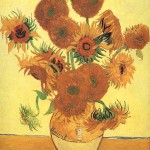
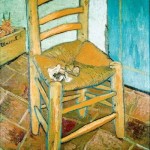

At The British Museum, I had a similar reaction to seeing and touching part of a column which came from the Parthenon. It is amazing how these artifacts have managed to remain in tact and meaningful for thousands of years. One sign that caught my attention was one which told the story of how Lord Elgin brought pieces of the Parthenon back to England in 1806. The signage, as well as other historians and archaeologists, claims that Elgin essentially saved the artifacts from further destruction and preserved them by bringing them to England. However, now that Greece has the means to afford an appropriate Acropolis Museum, there is much debate regarding the British Museum’s collection of artifacts, uncluding a number of friezes.
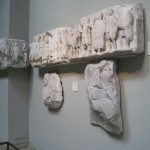
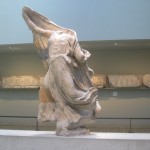
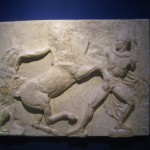
Both The National Gallery and The British Museum seem to honor artwork and artifacts over their historical context. Though considering where these pieces came from is crucial in understanding their meaning, perhaps where they are going, such as the friezes and sections of column of the Parthenon, and their relevance to our culture in the present and future is what should be more important.
Tags: Anya · Museums
This was initially a comment on Audrey’s wall, but I realized I hadn’t written my own blog post yet, and (more importantly) I was getting a bit preachy. So here it is:
I would first like to say that a city devoted to capitalistic endeavors is a beautiful thing. I look around and everywhere I see touristy traps– places trying to make you pay for restaurant seats and churches. Bath was no different, save for its own self recognition. It didn’t try to be anything it wasn’t. You want to drink our fancy water, you bet your ass you’re paying money. So hats off to you Bath and your unashamed stance, don’t ever apologize!
I, like Audrey and fellow travelers, tried to find the quintessential “Bath.” Far beyond the wrenching grasp of the tourist industry. I wasn’t looking for anything beautiful though, on the contrary. I attempted to walk to streets further into the realm of residential. I found parks with no names, pubs with local patrons drinking at 2 in the afternoon, and shady alleyways with no pretty walls or paintings of any kinds. It was no landscape shot, but there was a beauty in the simplicity. Sadly, I had no idea how to get home and wondered aimlessly for quite a while until like a beacon of hope I ran into Professor Qualls, who told me I was only a turn away from the church (I swear I had been wondering for a long time).
My love of Celtic heritage made going to Stonehenge cool. I mean the curiosity of the whole thing was pretty cool, especially seeing how the English lady on the head set phrased their speculation on its purpose. Honestly, I thought they weren’t very culturally relative: they kept applying a few modern ideas to the potential purpose. The thought that Stonehenge would be a symbol of power with other purpose seems a bit silly. Further, they kept bringing up concepts of hierarchy, which is complete speculation. Anyway
Next big thing was Borough Market, which was incredible. I have found my new love, sorry Planet Organic. How busy and hectic it was. The mushroom dip was especially delicious. Anything from Kangaroo burgers to a bottle of red wine can be found there.
I can’t exactly remember chronological order, but we saw Troilus and Cressida at the Globe Theatre, and I was quite happy with it. I felt they leaned a little too hard on the comedy side, but I was in a strange mood when I read the play initially. All the actors were fantastic and the visual aspects of the people were quite engaging. It is always interesting to read works based around the Trojan War. I remember when I was but a wee-lad, and my grandmother read the Illiad to me, thinking how amazing Achilles was and not really caring about Hector too much, but as I matured and read the work again by myself I began to sympathize more and more with him and less so with Achilles, which I think is the idea. Both warriors are bound by a sense of honor and fate. After watching this preformance, I felt that Hector was almost more enslaved to his sense of duty than Achilles was to his pride.
The British Museum was pretty cool, and I think I finally get what everyone else has been feeling. When I was at the National Art Gallery, Paul stopped me to point out Sunflowers, by Van Gough, and I wasn’t really sure what to say. Cool? But when I was at the British Museum, I came across something called the Dancing Shiva (http://dustysojourner.files.wordpress.com/2009/06/shiva_nataraja_musee_guimet_25971.jpg). Last semester I had been one tequilla shot away from having the thing on my back (which doesn’t always mean it has any value to one at all but in this case it did). I’m not sure why, but it’s a symbol I have always connected with. The Nataraja is meant to represent the destruction of the universe through Shiva’s crazy dance moves, but it is also meant to show the oneness of the universe. So there I was, standing in front of this bronze statue feeling as giddy as a little school girl, awesome.
The Cabinet War Rooms and the Churchill Museum. What to say? The Brits love their Churchill. One of the first lines in the head set was something along the lines of Hitler and Churchill both had a cabinet, but Churchill never overroad his. Why bring Hitler into this? The other thing that made me chuckle was when they were retelling the story about the hole punch. Churchill basically chews out this secretary because he uses weird words and she couldn’t figure out what he meant, and then the head set said: but he had a lot of pressure, so it’s ok. Not ok Churchill, not okay. Overall, the museum was a giant pat on the back for the Brits and their ability to live in small rooms for a long time. Seeing where they lived was neat, but it wasn’t incredibly informative and despite having creepy wax figures and listening to recordings, I never felt enveloped in the way, I think, they wanted to make the guests feel.
As a note, make sure you ask the ticket guy for a receipt because they don’t give you one otherwise, and there is no way to be refunded without it– your ticket isn’t enough, and the museum isn’t worth the ten quid.
Anyway, cheers
Tags: Andrew R
While going through the British Museum, the National Gallery and the Tate Modern I noticed the lack of British art and artifacts represented throughout these museums. I learned in my Museum Studies class that even major museums in America there are this lack of American artwork in them. Of course this is mainly because America is such a young country and we are beginning to establish our place in the art world just like other older countries have done. Even so, why is Great Britain still under represented, even within their own country?
I began to observe in every major museum in London that I’ve visited to so far this lack of British art. At the National Gallery there were only a few rooms (about 3) dedicated to the country’s artists. For being the “National Gallery” it seemed to be dominated quite a lot by Italian and French artwork. By viewing the layout of the gallery, it is easy to notice the complete lack of British art. It is also noticeable that it is not even the focal point of the museum, but the rooms displaying the artwork are pushed off to the side.
The British Museum also did not live up to its name. Great Britain only had about 4 parts of the entire “British” Museum showing British artifacts, mostly from the Medieval and Roman time periods. The majority of the museum displayed their stolen “acquisitions” from other parts of the world. And still even in this museum Great Britain was not the focal point in the least, for what is one of the first places you see when you walk in but the stolen Egyptian artifacts.
The Tate Modern also did not display many British artists. The gallery seemed to be dominated by American, French and all other countries other than Great Britain. Even America had a much larger place in this museum because of their prominence and prestige amongst the modern and post-modern art world. If you do a quick browse of this museum’s layout, it is easy to see hardly any British artists.
Why I believe there is a general lack of British art and artifacts is because most museums in a large city are meant to show off the prominence and power of that country. In the British Museum, Britain is still shown as a world power and it proudly displays the “booty” they have collected from their conquests of these other countries. Even in the new modern and post-modern art museum, the Tate, these same ideas still play through, just less pronounced than the other two. Museums are still viewed, even in the 21st century, as places of national pride and places to show off your conquests and the “treasures” to the rest of the world.
Tags: Alli · Museums
 Skate Park
Skate Park
“It should not be hard for you to stop sometimes and look into the stains of walls, or ashes of a fire, or clouds, or mud or like places, in which… you may find really marvelous ideas.” (Leonardo da Vinci)
There are no stains at the National Gallery, no ashes left at St. Martins-in-the-Fields church, no mud at Westminster Abbey. The marvelous rooms at the Gallery were spotless, eye-catching, almost enormous in their own way. The paintings were the definition of time’s constant, pitiless motion. Ageless. St. Martin’s church was divine, the concert we were there to see provided me with a sense of tranquility. The 3000 graves of the Kings and Queens at the Westminster Abbey were serene, spotless and preserved. Protected, like a caring mother protects a child during the most crucial years of his or her life. I have always been a lover of the arts, a person who admires the individual talent of those who seek self expression, yet the stains that I saw at the places above represented a personal frustration with the lack of representation of the, what some may call, “dark history,” I am thirsty for a history I have yet to explore.
As I walked the art-filled rooms of the National Gallery my soul wondered with joy, I was amazed at the pieces of art that stood in front of me: Van Gogh, Da Vinci, Michelangelo!!! I had seen these popular paintings on TV and magazines but I never thought I would the opportunity to SEE them, I was in disbelieve! yet the little girl in me who struggles to promote diversity at a predominantly white institution of higher education couldn’t help but to wonder: “Are there any non-white pictures in this entire gallery?!” I guess this is part of the challenge.
When I applied to the program I expected to encounter a culture not so different from my own, but these differences appear to be overpowering the few commonalities I can find and in this way I am challenged. Some who read this blog post may think, what is she talking about? or she is clearly exaggerating, but I come from a place of predominantly diverse communities, a place where our family members, teachers and friends are the Kings and Queens of of our history and they don’t need a $2 million shrine to prove it. I am challenged by the historical representations of the paintings and yet I am intrigued by the walls of the graffiti-filled skate park walls. I question myself for being unable to feel the same type of joy for both, for choosing the walls of the skate park (under the Royal Festival Hall) over the majestic walls of the National Gallery.
I continue to move forward, hungry to explore the unrepresented history. Desiring to spend more time speaking to a protester outside of the National Gallery, an activist, fighting for what he believed to be remnants of “institutionalized racism.” In him I find some comfort. Standing with him I felt inspired again. I was reminded that history, like art, evolves and is dependent on the author’s perspective. I must continue to appreciate what is in front of me, meanwhile assisting myself in the development of my own interpretations. I must not choose between graffiti and the precious work of Van Gogh but rather entertain my soul with both.
I think I may have found “really marvelous ideas.”
Tags: Flow
August 26th, 2009 · 1 Comment
So I’m beginning to realize that “free days” actually don’t mean that you get to relax any more than on “non-free days”. Yesterday Sarah, Chelsea and I decided to museum it up and we went to both the National Gallery and the British Museum (part 1). Since I am a history major and was considering art school before choosing colleges, I absolutely love observing all the details about paintings and artifacts in museums. History has taught me to look beyond the surface, so I am advising you to do the same because you’ll be surprised by the information you will discover!
I love looking at older paintings because they tell so much about the period and the people in them. For example, I was observing a portrait of a beautiful 18th century woman, and if I did not read further information about the woman, the painting would have lost so much meaning. The woman in the portrait, Manon Balletti, was actually one of the many lovers of the famous Casanova. Around the time this portrait was being painted, Casanova had declared his love for Manon, but she a few months later got married to another. On the surface, this woman looks demure and captivating, but with further research I now view this portrait differently.

Since I love learning about the every-day person and their lifestyle, paintings offer hints into things such as what people ate, what status a person is if a certain object is placed in the picture, how people wore certain types of clothing, etc. Being a historical reenactor as well, observing these paintings are one of the best research methods for a certain period of time. Who would have know that drinking hot chocolate would have been a status symbol in the 1700s? I had known this before, but apparently if a person was painted drinking or pouring a cup of chocolate, it showed that they were wealthy enough to afford such a luxury. Nowadays, we wouldn’t think twice before making ourselves a packet of powedery hot chocolate mix.
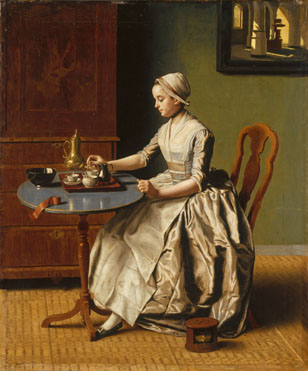
Portrait of a Woman of the Hofer Family, 1470, showed that it is always worthwhile to pay attention to details. If you only walked by and glanced as this painting you would miss the underlying symbolisim behind parts of the painting. In her hands she is holding flowers, symbolicly Forget-Me-Nots, which often signify rememberance. In the left corner of the woman’s headress there is a small fly made to look real. Oftentimes a fly could represent mortality or could just be used to show the artist’s skill of perception. I also noticed that in this painting, and in others from the period, some women wore rings on both of the joints on their fingers (which I think would be awfully uncomfortable!). I have never seen this before in paintings and in this one, if you look at the woman’s pinky finger on her left hand, you can see that she is wearing two rings. Perhaps eventually I will discover why it was fashionable to wear rings like that. It was probably one of those crazy fashion trends of the century.
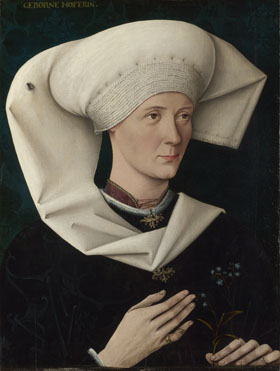
So the next time you rush by an old painting in a gallery or museum, stop and observe it. Ok, so maybe you can’t get past the “funny” headdress the woman is wearing, or the fact that men are wearing bright colored tights, but you can learn so much by looking beyond that. Perhaps you may even discover some parallels to a certain person or time period, such as people for centuries had portraits with their prized pets painted next to them, just like you might have your picture taken wih your favorite pet.
Tags: Alli · Museums
It seems appropriate to explain right off the bat that I slept through E.L.F in almost their entirety. I loved Phantasm, I thought the way the weaved in and out of pieces from phantom of the opera was incredible. Further, having played french horn since the fourth grade(stopping in college for lack of time and monetary excess), I absolutely love hearing one played. He was probably the crispest played I have heard in a very long time outside of a philharmonic. But yes, they were so amazing, they put me to sleep, which is something that happens with me around classical music–doesn’t matter where or who is judgingly starring.
Afterwards we went to the National Gallery where, as many others have noted, the only British people there were grumpy workers. the art was neat though; especially one painting called A Girl at the Window, by Louis-Leopold Boilly.

A Girl at a Window
I really like how it played with illusion. The painting itself was meant to look like a mounted print. It is almost as if she has caught us spying on her, an intimately understanding, yet coy smile. I must admit, I’m not the biggest fan of art galleries. Now you’re saying to yourself: Andrew, you fall asleep in concerts and you don’t like art galleries; are you total rube? And I might be, but I must at least attempt to defend myself. The art gallery was an interesting look into the distinction between American’s and the British. Firstly, there were barely any British people in the National Gallery, despite it being free. This is quite the contrast from the Philadelphia Art Museum or the one in DC, which frequently has art students and locals visiting and checking it out. Even the British guards seemed unhappy to be there. This can very easily be chalked up to the fact that it was a week day and in the afternoon because it seems strange that a nation so entrenched in their history would not care for their renowned artists. Further, I would wager that the National Gallery is far more maticulously organized. Comparing the websites(The American National Gallery and the National Gallery in London) shows this. The London National galleries website allows you to look up paintings by letter of artist’s name, period, and style– down to the exact painting. The latter gallery does not, instead only giving overviews. Everything was micro managed, down to the path you would need to take. Most galleries i have traversed have allowed for more free movement, and directional choice.
We left the gallery to peripatetically wander and instead came across an anti-zionist movement. What I thought was amazing about this was how volatile it seemed–on both sides. In America, for the most part, at least the cops remain calm (out of fear of being sued more than anything). Evidently the PM had returned from a vacation early. I have liked in a college environment for a good many years, so politcal discussions are commen place, but I have heard people talk about how strange it is to see protests and then post-protest discussions. People here just seem eager to debate, which I love. By that time Paul was in need of a Pasty, so we attempted to make our way back to tottenham court tube station (where it seems the best pasties can be found). While there, a brawl let out between an African fellow and an Indian fellow. They both seemed to speak english. There was evidently a problem with rolling over someone’s foot. It quickly escalated into a serious fight though. They tumbled into a carphone warehouse eventually. What was most interesting was the managers expression: he just seemed to annoyed by the going-ons rather than anything else. Like he was thinking ‘seriously? in my store?’ My two fellow travelers were thoroughly distressed by the situation, but it was startling how little anyone else seemed to care. In fact, the two fighting didn’t really seem to mind either. The Indian guy, hand on bleeding head, simply got up and walked away from the scene.
This post seems to be going a bit on the long side, so I won’t detail(and definitely should not) the clubing experience. But I will say it was interesting to watch the group dynamic, and our interaction with the Europeans, who seemed to not like dancing until American girls showed up.
There is no other way to describe Westminster Abbey other than ‘overwhelming,’ in every sense of the word. But if anything, I would say Westminster Abbey is not really even a church at this point. It is more of a mausoleum at this point: both for dead face people and British power. It has essentially become a 15 quid tour of the who is who of Britain passed, which is sad. It has very little to do with religion at all in fact. Don’t get me wrong, the building was glorious and unimaginably beautiful. Our tour guide was impecably brilliant and knowledgable. But I feel, the Abbey stands more in praise of England than in praise of God. I was most intreged by the enormous amount of symbolism cramed into every ounce of work. Masterful wood and stone working laid out generation long stories about struggle and triumph. I would have loved to just sit at one of the memorials and break down eat of the images. It also inspired me to pick up a life goal i had all but given up around the age of five: become a knight; we’ll see how that goes.
Afterwards we went to St. James park, which was full of tourists trying to feed bloated ducks. It even had an overpriced resturant in it. What was beautiful, howe
ver, were the flowers. They were exquisit. This is a very stark contrast from Hyde Park, which I had been to earlier in the week. Hyde park had much more local activity: children playing football, lovers and the homeless sleeping and runners running. Evidently, people were being charged to sit in chairs at St. James park–honestly, what is that?
We had our own bout with swindly prices today though. We stopped at an italian place to eat, and I got to laugh as almost everyone fell for the old still-water trick. Of course the joke was on us all when we realized we were also being charged for the seats. More and more I am realizing that pubs are the only safe place to eat or drink, everyone else just tries to screw you over.

anyway, cheers
Tags: Andrew R












 Skate Park
Skate Park



